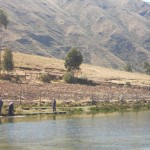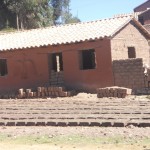Archeology
I don’ t know what I expected to find in Peru, other than a long trail and a big-ass set of ruins at the end. I expected alpaca, llamas, guinea pig. I didn’t expect to find archeology everywhere. It reminded me of Athens, and Rome, the ancient mixed with the modern, built on top of, making itself seen in flashes of stone.
Our second day in Cuzco, Kelly suggested that we see some of the archeological sites in the surrounding valley.
“You can take a cab up to the highest of the four sites and then walk back. It’s like 7 miles. We can do that, right?â€Â We were pretty sure that we could. LeAnna and I were heading out the next day for the 4-day Inka Trail trek. And Kelly was recovering from an Achilles injury. The question was more whether we thought it was a good idea.
“I’ll go ask the front desk about it.â€Â Kelly headed downstairs while LeAnna and I took turns showering and getting ready for the day. When she returned, it was with a big smile on her face.
“It’s $5 for the taxi…and she said we can rent horses!â€Â We stopped pawing through our backpacks and looked up at her beaming face.
“Horses?â€
“Yes! You can ride horsed back down. Should I ask her to call a cab?â€
An hour later we were climbing into a hatchback, the three of us crammed in the back seat, grappling with the stubborn seatbelts.
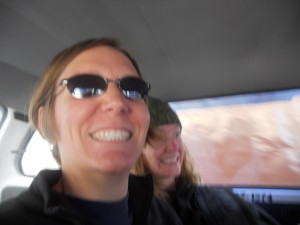
The driver wound through the too-small streets, rattling along the stones, as people jumped out of the way onto sidewalks or up into doorways.
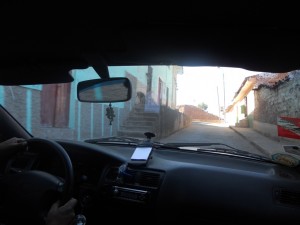
As we drove up and out, we were treated to a view of the city, nestled in the hills high above the distant sea.
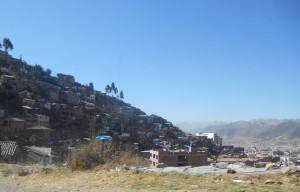
Here we found locals. Real ones. Dressed in the functional clothing that kept them both warm in the morning chill of 12,000 feet and safe form the uv rays of the sun, relatively unfiltered by the thin air.
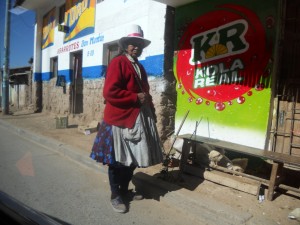
Our taxi driver dropped us at the topmost of the four sites we would see: Tambo Machay. We were greeted by dreadlocked donkeys and llamas rolling in the grasses.
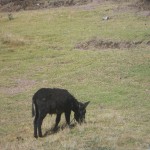
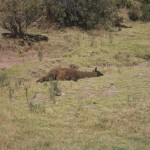
The focal point of this site was water. From the spring running along side the path leading to the ruins, to the incorporation of the water in the beautifully hewn stone, there was no question about its importance here. Beautiful trees grew on the banks of the little spring, shading the path, providing a rare bit of shade. Despite the biting chill in the air, we lingered out of reach of the sun’s searing rays.
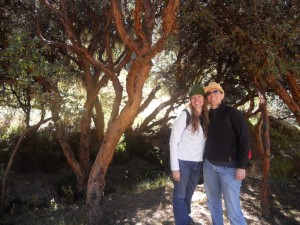
Merchants walked the path, back and forth from a make-shift marketplace at the foot of the ruins, carrying their wares and offering pictures with their livestock.
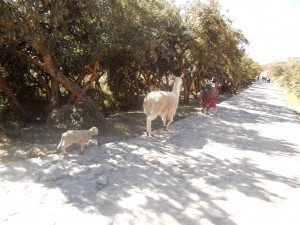
The archeological site was beautiful. The stones were smooth and impeccably placed. The thousand years or so of weather only a mild nuisance to its grand presence. The aqueducts were clearly deeper than they had been when they were originally cut into the rock; worn away by centuries of flowing water.
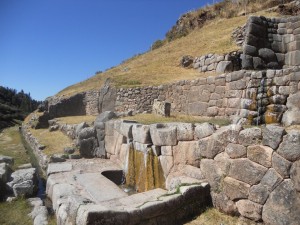
The niches, possibly used to display mummies – a connection with the afterlife – still retained their pink hue, and sharp angles.
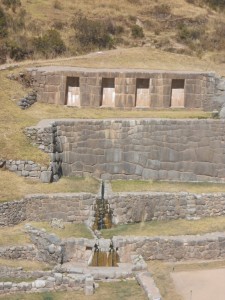
We climbed to a viewing area and surveyed the site. Locals gathered water from the spring, the market spread out in a colorful patchwork of textiles, and a shepherd brought his sheep along the ridge just above the site, the modern mixing seamlessly with the ancient.
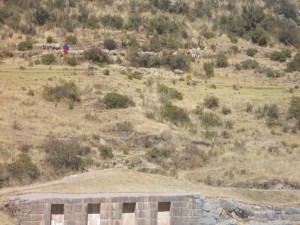
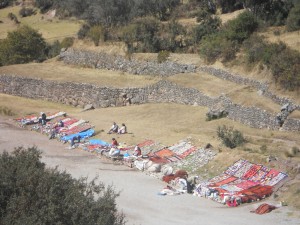
From Tambo Machay we walked down the winding road that had brought us from the city. Our next stop, Puca Pucara, was just across the way, a sentinel balanced over the valley.
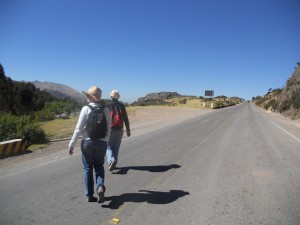
If Tambo Machay was about water, Puca Pucara was about the earth and air. Wind whistled around the site, open on all sides to the elements.
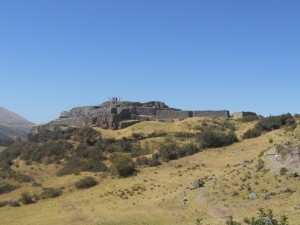
When we walked up we found a young man and woman who wanted to show us the site. “Just for tips.â€Â We declined, but I was intrigued. “Without knowledge, this is just a pile of rocks,†he called after us. We had our guidebook, but his words stuck with me. How interesting that we had traveled all this way to see a pile of rocks. To walk on a pile of rocks that had been so carefully placed. How curious.
On the inside we found carefully constructed windows, small niches, walls built in harmony with the rocks upon which they stood.
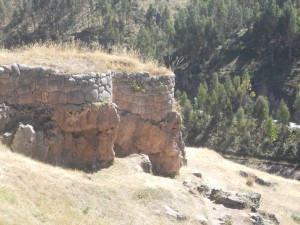
And a cave. LeAnna found the little opening, and we contemplated the intelligence behind entering. None of us had brought a head-lamp, which, in the end, probably saved us from making a foolish decision.
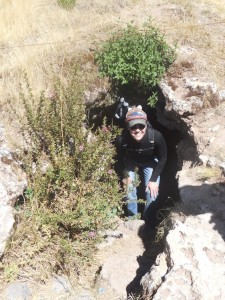
The thorn bush and stinging nettle pleaded with us to turn back. Which we did.
The site had a good number of rooms, layered on top of each other. We climbed stairs cut into the mountain, and spent time looking out at the valley. It was clear that this site was placed so as to offer a view, whether for aesthetic or military purposes. In fact, its purpose as either a hunting lodge or a fortress is still in question.
This was our first introduction to a couple of things. First, the small, uniform niches that decorated the inner walls of the sites. They were perfectly sized to house me.
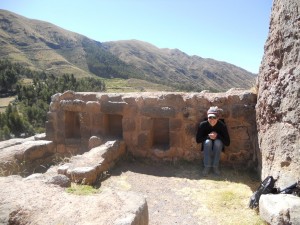
Second, we were introduced to the mountain-shaped rocks carved by the Inka, sacred objects that we would have walked by without knowing they were there. This stone at Puca Pucara was shaped like the entire site of Machu Picchu.
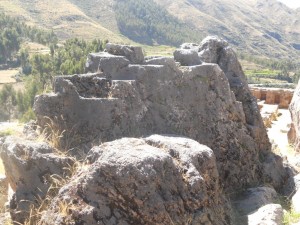
As we walked from the site, Kelly started to feel the uncomfortable crisp that was beginning from spending hours in the high-altitude sun. Even her stylish straw hat provided little protection.
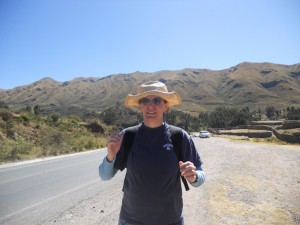
A quick reassignment of clothing resulted in a charming expedition-worthy outfit.
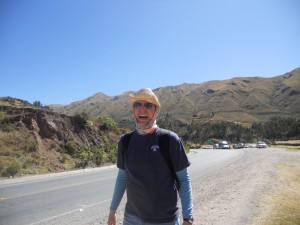
I think that one of the greatest parts of traveling with other people is that I don’t have to be the only one to look like a fool on a regular basis.
The walk between Puca Pucara and the next site of Qenko was the longest leg. We passed a wildlife refuge (about an acre of flooded grassland), fields of great clay bricks drying in the sun, and animals of all sorts.
My favorite was a pig, ridiculously tethered to a clump of grass.
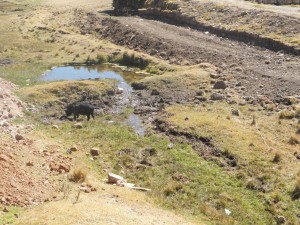
As we turned a corner, the road swinging wide out over the valley, we saw a pack of horses, and two men sitting in the grass. We all smiled and waved. We’d nearly forgotten about the horses! A quick negotiation, and we were on horseback, our guide walking beside us.
My horse was Palomo. A beautiful, dusty white guy who was assigned to me, after I volunteered that I’d ridden before.
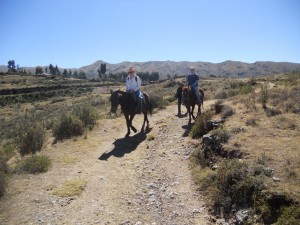
The ride was great. We meandered through the hills, cutting across the country-side, up and down rocky embankments, and splashing through wild springs.
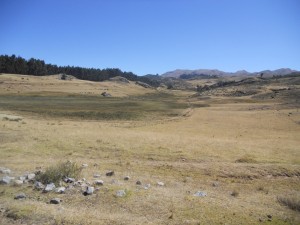
Kelly chatted in Spanish with our friendly guide, and I tried to slow Palomo who clearly preferred to run ahead of the pack. Only once did we stop, our guide ordering me off of the horse, and instructing Kelly and LeAnna to continue on. They looked at me and stayed put as our guide walked over to Palomo and adjusted the saddle, which had slipped back considerably.
With graceful movements, he adjusted the straps and moved with the horse when he sensed the argumentative kick coming.
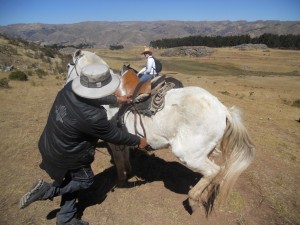
As we neared Quenko, our guide gave us the go-ahead to let the horses run. That was what I’d been waiting for. All thoughts of a slipping saddle were thrust aside as I nudged Palomo on.  And we flew, through the hills of Peru, a huge smile on my face, and a chortling rumbling up from my soul. Up the hill and into a lane filled with other horses, and we landed, Palomo taking charge of where and when to stop.
We hopped down, said our goodbyes and headed up the lane in the direction our guide pointed. We were in a distinctly agricultural area now. Workers were bringing tubs of potatoes from the fields to dry in the sun.
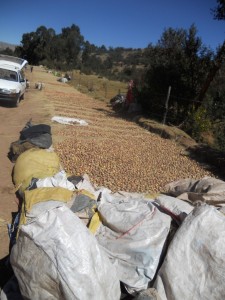
We spent the next while at Quenko. It was lunch time, and we made a familiar picnic of trail mix, dried peaches and cheese. The horses had been a delightful break in the day and we were all smiles as we hydrated and rested our thighs.
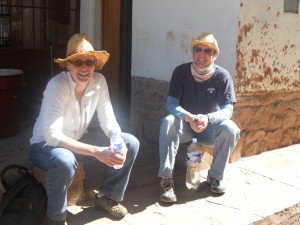
This site was different from the others. It was carved into the rock. Zig-zag channels and natural crags replaced the carefully-formed walls of the other sites. We walked along the path to the site, noting the differences.
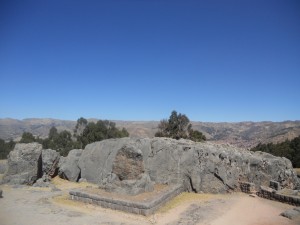
And then we were in the ruins. Literally, in them. Quenko was all about the earth. The great cave in its center was a clear focal point. The altar, carved from “living stone†is thought to have been used for embalming. Mummies were an important part of Inka culture, serving actively as a connection between this world and the next.
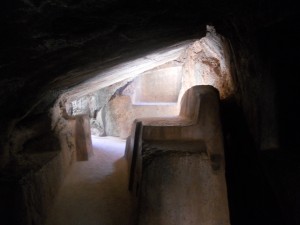
Between the altar and the niche at the far end of the chamber was a great crevasse. LeAnna and looked up at the piece of sky above, and the clear path to the surface. And then we jumped. She did a neat tuck and roll away from the edge, gently sloping down into the bottomless earth. I made a comment under my breath about not having health insurance. Halfway through the muttered doubt, I slammed the edge of my knee into the edge of the unforgiving stone. One day before the longest trek of my life.
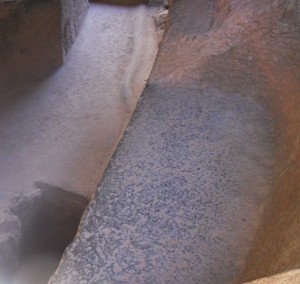
Even with the purple bruise already blooming, I was able to walk, so I shook it off and looked back, thankful that I was above, and not an offering to mother earth.
Up above, we met a young man anxious to talk with us about the site. Not for tips. He introduced himself and his culture and told us he was preparing to be a shaman.
“In two weeks.â€Â He had that long to prepare. He’d been coming to the site every three days for the last 6 months or so, and was ready to join his father, grandfather and great-grandfather as a shaman.
“That is a good sign for you,†he said pointing to two small butterflies that were fluttering together 5 feet from the ground.
He pointed out the phallus-shaped site visible from where we stood – the companion to the uteral cave we’d just escaped from – as well as the male and female mountains visible from where we stood.
We thanked him and walked back to the road. Without horses to guide us, we chose the road that seemed to be headed most directly down and began our journey to the final site. We walked past houses and fields, llamas and soccer goals.
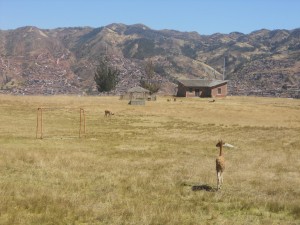
Sacsayhuaman (pronounced “sexy woman”) our final site for the day, was the largest, by far. The Cuzco region is said to be shaped like a puma. Sacsayhuaman is known as the puma’s head. The walls of the site form jagged, tooth shaped battlements – the puma’s mouth. Even from a great distance, it was easy to see why.
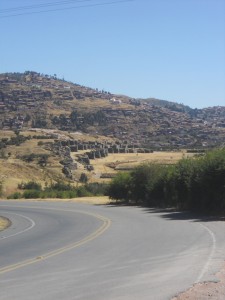
The road took us out of the way, through a small resort, and next to more llama pastures. As we walked past one, a herd of llama escaped, running through an unsecured gate. We considered whether we were morally obligated to attempt to wrangle the llamas.
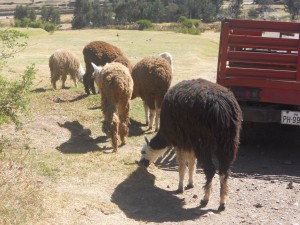
We decided, no. We were not.
Once at the ruins, we found a spot in the shade to relax and hydrate.
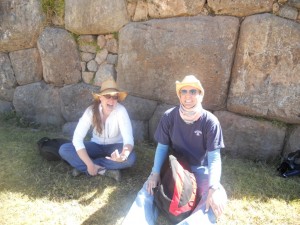
And to take in the enormous Cristo Blanco standing opposite the ancient Inka site.
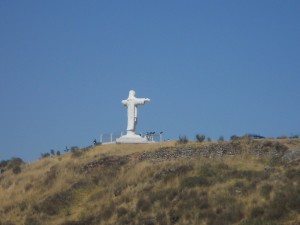
The site was gigantic. We spent at least an hour there and saw a small fraction of what there was to see. The stones that were used were incomprehensively large. One was something like 70 tons.
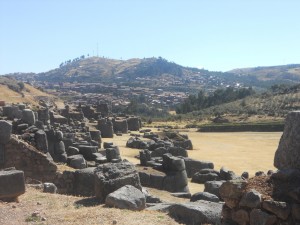
We wandered through the doorways, up the steep stairs, along terraces.
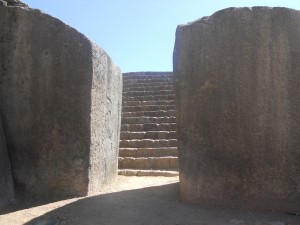
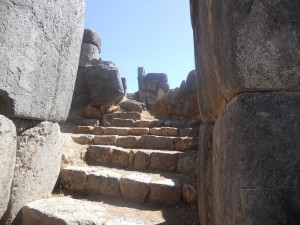
We contemplated the strange, chalk grids marked on the walls, designed to help reconstruct the site in the case of an earthquake.
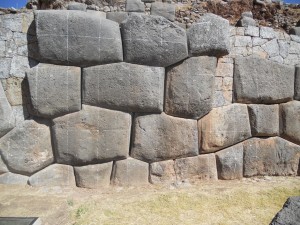
I also perfected my Peru look.
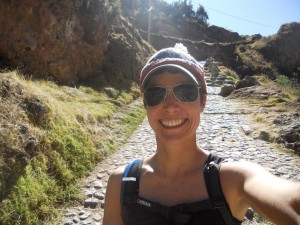
The hat kept me warm, the camelback kept me hydrated, and the tank let me get some sunscreened rays.
And then we went in search of the old Inka trail that our guidebook said we could take form the site down into the city itself. But there were a lot of stone trails. Eventually, we chose one that we thought looked promising, and headed down hill on the worn stones.
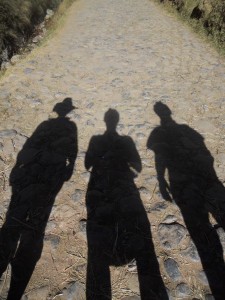
We made our way back into Cuzco, alongside the stray dogs that inhabit the streets. Along side the tiny, old women walking the sidewalks, and the insane motorcycles carrying propane tanks strapped to their metal frames. We walked back into the city with a boy and his grandfather carrying loads of rubbish on their backs.
We walked back into the city and directly into a pizza place.
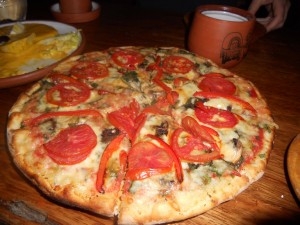
Along with the excellent pizza we had what became our favorite meal, avocado relleno.
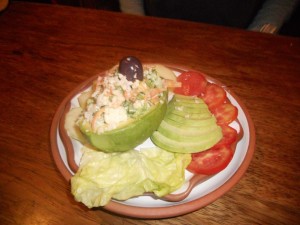
One of the vegetable dishes that we could eat, the avocado relleno was stuffed with boiled vegetables and cheese. It was delicious.
We also sampled a local potato and egg-sauce dish that wasn’t shabby, even if we weren’t exactly sure what we were eating.
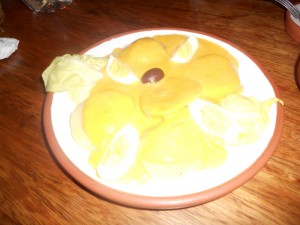
And we each had a local beverage. LeAnna opted for some kind of juice, Kelly for hot chocolate, and I won out with a huge mug of coffee, served concentrated with a beaker of hot water.
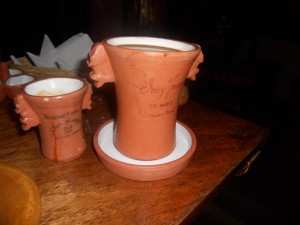
While we ate, the World Cup played in the background. Locals leapt up periodically to cheer on a particularly good play. We spent the rest of the evening doing laundry, walking the Plaza Armas, and in a briefing for the next day’s Inka Trail trek. But generally we were waiting until it was dark enough for us to return to the cake shop for dessert.
Which we did. It was good. I even ate a cheese sandwich. And I think we shared four desserts. But we’d been walking and riding and learning all day, so we were hungry.
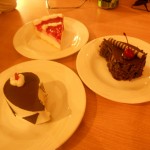
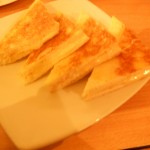
With full stomachs, we went to bed early, ready to wake up at 4AM and catch our shuttle to the Inka Trail, and our next adventure.
August 24, 2010 1 Comment
Half-buried
Italy is old. It has an ancient feel about it. Yes, I know everywhere is old. I know there were native peoples in the US thousands of years ago. But, somehow, Italy feels different. Like the land has been dealing with foolish people for a very long time. You know, like the Roman Empire, and whatnot. People determined to bring about their own destruction through over-estimation of their own powers.
Now, I’m not saying that’s what happened at Pompeii. It’s not like the people there angered Mt. Vesuvius with their self-absorption. By all accounts, it was an average place, with its bakeries and villas and brothels.   Humblingly so.
The day we visited Pompei, the Ant and I got up early and caught a bus into town. Unfortunately, we missed our train by about 2 minutes. The guy at the ticket counter sold us something that looked different than the usual tickets.
“Are you sure we didn’t buy bus tickets?â€Â The Ant wasn’t at all sure about these new passes. “I think you should ask.â€
A quick question confirmed that the passes could be used for both buses and trains in the region. That was great, but the next train wasn’t for several hours. We walked across the street to our favorite tourist information office to see what our favorite tourist information officer could tell us.
“Alora, you can take the bus at 11:05.â€Â Crap. That was still 2 hours away. “Aspetta. Wait. There is one at 10:05, right out front.â€
We grinned, thanked her, and left. We had just enough time for breakfast at our favorite gelateria/coffee bar.
With pastry in our stomachs and caffeine in our veins, we ventured into a tabacchi to buy stamps. We were really feeling good about our ability to get around and get things done.
At 10:00, we boarded the correct bus, picked out the best seats (we’d ridden enough busses to know what the best seats were) and settled in. When we pulled out at 10:05 there were only about 5 of us on the bus.
Along we drove, through the countryside, and through cities. Young boys got on and off, eying our bags hungrily. The cities got grittier and grittier, with unsurprising names like “Angri.â€Â The ride went on for what seemed like an eternity. I got up to check with the driver.
“Andiamo a Pompei, si?â€Â Nothing. “A Pompei?â€Â He nodded and grumbled a bit. I returned to my seat to scour my Rick Steves section for clues.
There are times when my trusty guidebook is super-helpful, and times when I could throw it in the fire. For the most part, our trip to the south wasn’t greatly aided by the guidebook. Our day in Pompei was no exception. Rick had some decent information on how to get to Pompei from the north, but the approach form the south had nothing. His description told me that if we got off at the train station, we’d be super-close to the entrance to the ruins. I checked the name of the station, and figured that if we could get off somewhere close, we’d be good. I mean, how big could Pompei be?
So the answer to that question is that Pompei is a kind of suburb of Naples. It’s big. When the bus driver stopped and announced “Pompei,†looking back at us, I got up and took the Ant with me.
I could have asked if this was the “stazione†stop, but I didn’t. Frankly, I was tired. I was tired of thinking in a foreign language.  I was tired of formulating questions, practicing them and then bungling them with less-than-helpful bus drivers. I was tired of the shrugs and the grunts and the anxiety that comes with rejection from strangers. Not that it was always like that. Just that it was always a possibility. And I was tired.
So, we got off and started walking. There were signs for the station – in the direction that the bus had driven. We followed them for maybe 5 minutes until we came to the “Centrale†station. This wasn’t the “Scavi†station that Rick had mentioned in the guidebook. I confirmed with a cabbie who wanted to give us a ride. We were 3 Kilometers away from “Scavi†and he’d gladly take us there for 10 Euro.
Forget it. I looked at his map, and thanked him. Then we took off, walking through the streets of modern Pompei. It was still morning, and fairly cool. Even so, I think I mentioned to the Ant how much I’d always liked the phrase, “sweating freely.â€Â I’d grown accustomed to having my jeans soaked through with sweat, and my wool t-shirt damp at all times. It reminded me of Aragorn running through the hills on a great quest in the Lord of the Rings. Yeah, I’m that kind of crazy.
We walked for about 30 minutes, following signs for “Scavi†and trusting that we’d know the ruins when we saw them. According to Rick, we’d hit the ruins before the scavi station. We walked past huge churches and interesting apartment complexes.
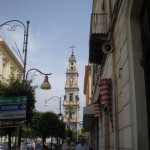
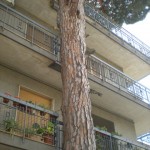
We greeted young men (I swear we saw 3 times as many men as women in Italy. I don’t know if the women are all working, or just at home with the kids, but the guys were out wandering, and drinking coffee), who all smiled at us kindly.
Lemons were everywhere. I knew lemons were an important product in the south, but in Pompei, the were seriously everywhere.  Rotting bags of them littered the street and huge, obscene fruit hung from carts.
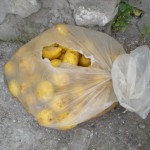
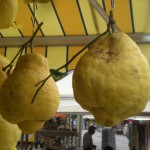
We stopped periodically for water, and I commented on how the heat really doesn’t bother me, and how important it was to make sure we stayed hydrated. “Six ounces every 15 minutes,†I sang. A familiar refrain to my softball friends.
By the time we reached what looked like a tourist area, we were both a little tired, and more than a little ready to be there. “Scavi,†read a sign, pointing up a driveway that led up a hill, and out of sight. We’d seen several of these signs along the way, often pointing in different directions. We looked at each other and sighed. It seemed like were almost there. In the back of my head I wondered what had gone wrong, and how we’d be getting home. Oh well, it always worked itself out.
Up the hill and around a corner, we found the gates to the ruins. As we approached, beautiful displays of even more lemons invited us in.
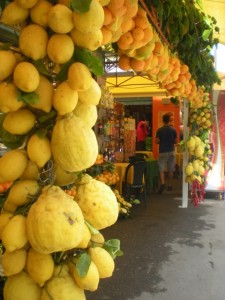
As did a “local tour guide†in his over-sized, crumpled ballcap and aviator glasses. “English? Wait 10 minutes I will organize an English tour. It will be much more affordable,†he barked at us.
“No, grazie.â€Â I wielded my familiar vendor response to little effect.
“English?!â€Â He was demanding. “Please, go this way and purchase your ticket. I will arrange a tour.â€Â The local tour guides, and even random people looking for a handout will masquerade as helpful staff members. This guy was pointing us to the ticket office. Fortunately, Rick had warned us about this, so we were prepared. Others seemed baffled.
Once we had our tickets and free map (thanks to Rick’s excellent information about where to get one), we hit the WC. The entire time, we listened to the barker trying to organize the tour. “Next tour English with local guide. Next tour in English! Please, purchase your tickets! This way…â€
Feeling just a little superior in our knowledge, we emerged, skirted the guide and headed to an overlook area.
The last time I was in Italy, it was the off season. O-F-F. There aren’t a lot of tourists visiting Rome and Venice in November and December. I’d like to keep it that way. Standing at the Pompei overlook, I flashed back to a CS Lewis novel I’d read as a kid. “The Silver Planet†was this great sci-fi story about, as I remember it, a man who goes into space for an extended period of time, living on another planet. The part that came back to me now was a scene when, after a long time away from home, he watched unfamiliar creatures come over the horizon, hairy and gruff in their manner, speaking a harsh, unbeautiful language. It took him a moment to realize they were humans speaking English.
All around me, the beautiful melody of the Italian language disappeared into a sea of shouted names, pushing, scrambling as though the ruins would somehow be used up, fear and scarcity the dominant energy.
“Let’s get inside, shall we?â€Â I could hardly bring myself to look at the Ant. I just wanted to disappear.
Once out of the crowd, I took a moment to look around. Pompei is amazing. It really is “You’re going to be amazed, girl.â€Â I’d been told by my buddies that this would be an amazing experience. But it’s hard to prepare for something like Pompei. In fact, I’m not sure there’s a lot I can say about it.
We walked through the forum, along the streets. We noted the stepping stones that allowed chariots through and provided a path for pedestrians when the streets were flooded for cleaning every night.
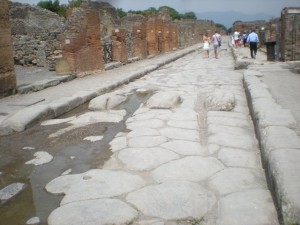
We looked into the distance at the crater of Vesuvius, and imagined the plume of ash that had risen from it. And fallen where we were standing, killing and preserving everything. Leaving the record we were now snapping pictures of.
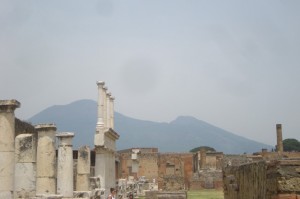
We saw bold-colored frescoes and strong mosaics.
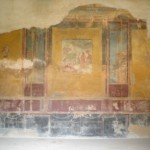
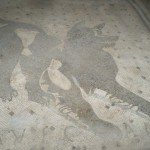
Shrines and fast-food joints.
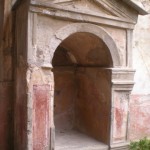
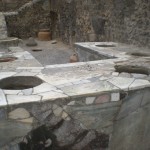
Huge pots, half-buried, and intact dotted the rooms.
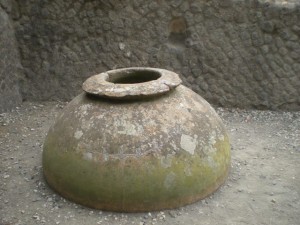
And tourists crowded along the fence that protected the remaining artifacts. The tools, and art left behind. And the people. The plaster casts made from the spaces left when the bodies of Pompeians had decomposed.
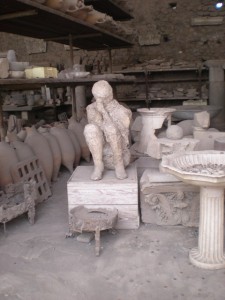
I took a picture of one of the most famous and left the rest to be mobbed.
My favorite part of the site was the public baths. From the beautiful outdoor gymnasium,
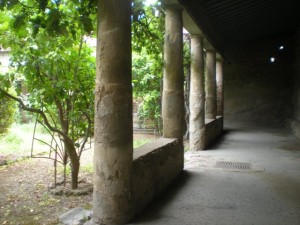
To the immense steam fountain inlaid with the names of the politicians who paid for it.
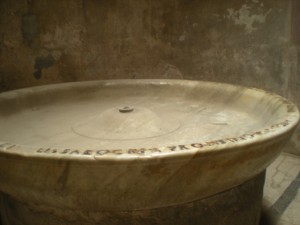
The baths provided an intimate look into the life I would have been most drawn to in Pompei. At once physical, artistic, and engineered, they intrigued me with their temperature-controlled double walls and bronze heater. They were so well preserved that they reminded me of images of the gym on the Titanic.
This place really was amazing. We wandered around, taking in the 2,000 year old lead pipes, and the water-towers. The double-boilers that kept food warm. Then we took in the snack shop. And the Powerade. Pompei was cool, but it was also hot. Really, really hot.
And I swear it had ears. Just like Venice it heard me bragging. And it landed me on my ass. Even after drinking several bottles of water and a Poweraid, the ground was shifting under me. My statement about not being affected by the heat caught in my throat.
“So, what do you think about heading back?â€Â I wasn’t usually one for leaving anything unseen, but I wasn’t used to having my body betray me, either.
The Ant looked at me. “I wouldn’t be upset if we headed back.â€
“Okay, then I think it’s time. My body is rebelling.â€Â Along with the baths, I’d really wanted to see the brothel, and its frescoes that served as a kind of menu of services. But at that point, even the dirty frescoes were forgotten.  All I was thinking about was finding the “Scavi†train station that Rick Steves had promised was so very close to the ruins.
I consulted the Pompei section of Rick’s book that I’d torn out and put in my pocket. I reversed the directions from the station to the ruins, and determined that we needed to go right. After walking for about 10 minutes, it was clear that something was wrong.
“Maybe we should go in and ask,†suggested the Ant, pointing to a tobacco shop.
“Maybe.â€Â I was still having an attitude crisis about having to ask directions in Italian. Still, I walked in to the tiny shop and waited behind a couple of local guys to talk with the shopkeep, who was sitting on a stool behind what looked like bullet-proof glass.
“Prego. Dove il stazione?â€
All three guys answered. Waving their arms, they pointed us back out and to the right. On the way we’d been heading.
“Grazie, ciao!â€
I walked back out to the Ant. “Yeah, they said to go up here.â€Â  Neither of us was too excited to keep on, in the opposite direction from the “Centrale†station we’d been at earlier in the day. But, on we walked, wondering when we’d see the station.
There were scarce few people on the sidewalk, giving us little opportunity to confirm that we were, indeed, headed in the right direction. So when we saw a man getting into a car just ahead of us, the Ant lunged forward, suddenly inspired.
“Staztione?â€Â she ventured.
He responded in rapid Italian.
“No parlo bene. Mi dispiace,â€Â I interjected. We weren’t in any space to work this out in Italian.
“English?â€
“Yes. Where is the train station?â€
He pointed back the way we’d come. “Three kilometers.â€Â Damn.
“Stazione Scavi?â€Â Rick said there was a Scavi station close to the ruins.
“Where are you going?†he asked.
“Salerno.â€
“No, Stazione Centrale. There is a Circumvesuvia station here, but it does not go to Salerno.â€
Shit. That’s the line Rick had talked about. I hadn’t considered that it wouldn’t go to Salerno.
“Okay. We know Centrale. Grazie. Ciao.â€Â Well, at least we knew where we were going. It was just another 20 minutes we’d added by walking this way in search the Scavi station. We pulled out our water bottles to hydrate. Our guide got in his car and began to drive off. I was a little disappointed. After our excellent experiences in Potenza I’d really rather expected that he’d offer us a ride.
Then he pulled up to us and got out of the car.
“There is another station closer. Torre Annunziata Centrale.â€
“Come?â€Â I caught a couple of the words, but this was a crazy name.
“Torre Annunziata Centrale.â€Â He pointed back the way we’d been heading.
“Okay, how far?â€Â The idea of another wild goose chase wasn’t interesting to me.
“Maybe 15 minutes if you walk. But 2 minutes if I drive you.â€Â He opened the back door.
“Grazie.â€
We climbed hungrily into the air conditioned interior of his black sedan. I nearly told him he was an angel, but thought I’d hold back to see if he slaughtered us, first.
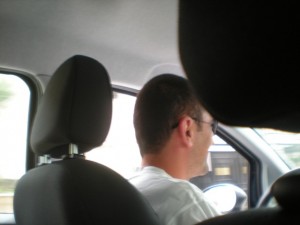
“Is this your first time to Pompei?â€
“Yes. Are you from here?â€
“Yes. Well, from Naples. It’s all the same.â€Â Oh really. That explains how we could be walking for an hour in one direction and not reach the end of the town.
“Thank you for the ride. Molto gentile. What is your name?â€
“My name?â€Â He seemed amused. “Angelo.â€Â Of course it was. Of frickin course.
“Grazie mille Angelo.â€
“Niente.â€Â How could he say it was nothing. It meant so very much to us, strangers who were so very tired.
He dropped us at a little train station and we headed inside, waving goodbye. I looked up and noticed a street sign. A brown one that had a picture of ruins on it. And said “Scavi.â€Â No way. And it dawned on me. Scavi meant ruins. Yes, there might be a “Scavi†station, but all the signs we’d been seeing pointing in different directions weren’t signs to the station. They were signs to the ruins. Cazzo. I almost laughed at myself. Almost. But I was too tired.
We checked the departure board. The next train was leaving in 20 minutes. Just enough time to pee and find the right platform. And to learn the name of the station.
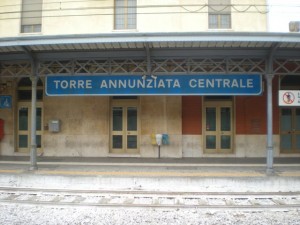
No way. I didn’t need to know the name of the train station.
July 1, 2010 1 Comment

